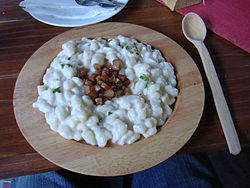Halušky
This article needs additional citations for verification. (December 2016) |
 Bryndzové Halušky with bacon | |
| Type | Dumpling or noodle, gnocchi |
|---|---|
| Main ingredients | batter (flour, potatoes, bryndza cheese) |
| Variations | Bryndzové halušky, Kapustové halušky, strapačky, noodles & cabbage |


Halušky (IPA: [ɦaluʃkɪ] in Czech and Slovak, singular: haluška (a single dumpling); Template:Lang-hu, haluska or nokedli; Template:Lang-ro; Template:Lang-sr; Template:Lang-uk; Template:Lang-lt,Template:Lang-de) are a traditional variety of thick, soft noodles or dumplings cooked in the Central and Eastern European cuisines (Slovakia,[1][2][3] Czech Republic, Poland, Serbia, Ukraine, Lithuania, Romania and Hungary). Halušky can refer to the dumplings themselves, or to the complete dish. Bryndzové halušky is the national dish of Slovakia.
Preparation
Halušky dumplings are made from a batter consisting of flour and grated potatoes. The batter is spread on a wooden cutting board, from which small pieces of the batter are dropped into boiling water. They can also be made with a special perforated cooking strainer (haluškar) from which the batter is dropped directly into the boiling water through small holes in the haluškar.
Although recipes vary from region to region, in general flour is mixed with grated potatoes to form the batter. Salt and sometimes an egg are added, but bryndzové halušky, the national dish of Slovakia, usually does not include eggs. After cooking, the Halušky are mixed with various ingredients, such as bryndza (a special cheese made mostly from sheep milk), bacon, and bacon fat. In some parts of Slovakia, caramelized butter and cabbage, onions, or combinations of these items are used instead of bryndza.
Variations
Bryndzové halušky is a traditional Slovak dish also found in Moravia in the eastern part of the Czech Republic. Kapustové halušky is a similar dish that's made with fried cabbage (and/or onions) and caramelized butter instead of bryndza. Strapačky is another variation of halušky in which stewed sauerkraut is used instead of bryndza. In Hungary, galuska are often eaten with meat stews, such as goulash or pörkölt.
In the United States, most adapted halusky recipes call for egg noodles rather than potato dumplings. Some American cooks include loose, cut, and fried green cabbage (a convergence with strapačky, compelled by simplicity, difficulty in finding bryndza or acceptable substitutes, and access to affordable cabbage in areas with prominent existing Slavic and Germanic immigration).
See also
References
- ^ Salaman, Rachel (2003). "Halušky: Humble King of the Slovak Kitchen". Spectacular Slovakia. Retrieved 2008-09-11.
- ^ Salaman, Rachel (2003-01-20). "Halušky: Like gnocchi only smaller and tastier". The Slovak Spectator. Retrieved 2008-09-11.
- ^ Reynolds, Matt (1999-06-21). "Three liters of bryndzové halušky small work for hefty men in national eating competition". The Slovak Spectator. Retrieved 2008-09-11.
